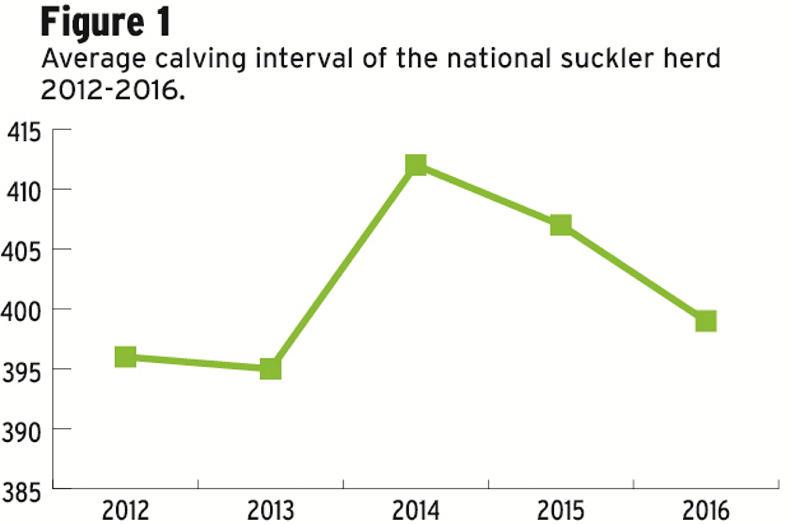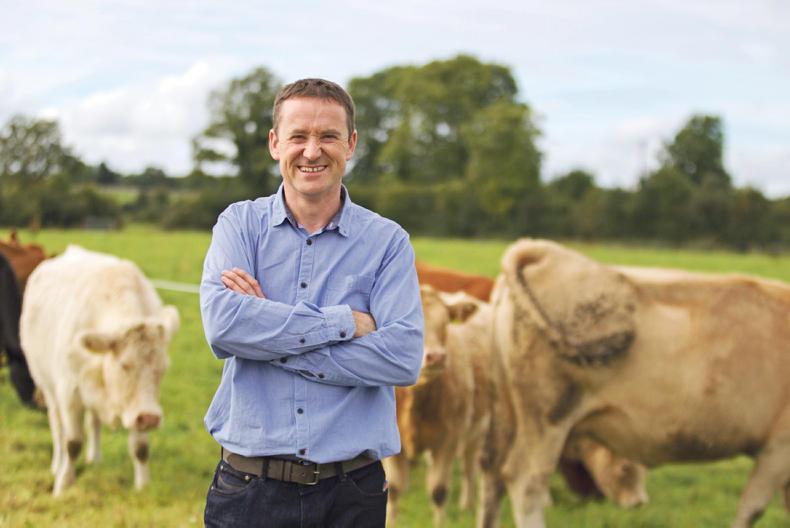While this improvement is good news, we cannot ignore the fact that the average Irish suckler cow is still only producing a calf every 13 months.
Important performance indicators
Aside from calving interval, there are a number of other key performance indicators (KPIs) for a herd’s fertility.
Calves/cow/year
This is a key indicator of output for a suckler herd. The national average has seen a very marginal improvement from 0.82 in 2015 to 0.83 in 2016, meaning that for every 100 suckler cows there are only 83 calves being produced. If a 20-cow suckler herd increases its calves/cow/year figure from 0.8 to 0.95, it will mean increasing the number of calves produced from 16 to 19. Having three extra animals to sell per year would result in a significant increase in revenue for a herd.
Percentage of heifers calved 22-26 months
There has been huge emphasis by the industry in recent times on the merits of calving females at 24 months in an effort to encourage more farmers to adopt this practice.
There has been a slight increase in the percentage of heifers calving between 22-26 months, rising from 18% in 2015 to 20% in 2016, but this still means that only one in five suckler replacements calve for the first time at the optimum age. The average age of first calving for beef heifers is 31.5 months. This naturally means that there is a significant increase in the cost of bringing a suckler heifer through to first calving.
Fertility and the Replacement Index
Fertility traits such as age of first calving and calving interval make up 23% of the Replacement Index. While environmental factors such as nutrition, health, heat detection, etc, have a large impact on a herd’s fertility performance, genetics also have an important role to play.
Analysis of national stats by ICBF consistently demonstrates the superior fertility performance of high Replacement Index (five-star) cows over lower index cows. Table 1 details the difference in the key fertility traits (age of first calving, calving interval and survival) between five-star and one-star cows born in 2011.
My herd’s fertility performance
Beef calving reports were posted to 13,500 herds last week. This report is made available to farmers through the HerdPlus service and allows you to fully assess a herd’s fertility performance and to compare the herd to the top 15% of herds as well as national averages. If you wish to know more about the beef calving reports or any other element of the HerdPlus service, please contact ICBF on 023-882 0452 or email query@icbf.com.

Table 1: Comparison of 5 star and 1 star cows born in 2011 on key fertility traits
|
Age first calving (months) |
Calving interval (days) |
Survival (% still alive) |
5 Star |
30.1 |
403 |
83 |
1 Star |
32.1 |
423 |
72 |
How do I access the calving performance figures for my herd?
Calving figures are made available to farmers through the beef calving report. This report is part of the ICBF HerdPlus service and allows you to fully assess the calving performance of a herd and compare it with the top 15% of herds as well as national averages.
What fertility targets should I set for my herd?
You should aim to have an average calving interval as close to 365 days as possible, with a calves/cow/year figure in excess of 0.9. While calving heifers at 24 months may be an alien concept to some farmers, it can have significant economic benefits if implemented properly. Talk to your agricultural adviser about setting fertility targets for your herd.
FARMER FOCUS: JOHN O’HANLON
A change in breeding strategy 
Name: John O’Hanlon, Ballymahon, Co Longford.
Farming System: Suckler to weanling/store.
4 and 5 Star Females: Cows: 23; Heifers: 4.
Stock bull or AI: Stock bull/AI.
Replacement Strategy: Changing from buying to breeding my own.
John O’Hanlon runs a 40-cow suckler herd in Ballymahon Co. Longford, on a part-time basis alongside a job in the local mart. John was one of four farmers profiled in the BDGP training videos. John outlined how he would need to make some changes to his breeding strategy to meet the programme requirements. We catch up with John to see how he is progressing.
What is your farming system?
I sell the heaviest of my bull calves in the autumn as weanlings. The lighter bulls are castrated, carried over the first winter and sold over the course of the following summer as stores. All heifers are over-wintered and sold as stores. I’m now starting to breed my own replacements. Even though it wasn’t my initial intention, I used AI on 15 of my highest index cows to breed replacements. I also purchased a high Replacement Index bull.
What changes have you made to your breeding strategy?
I was running two terminal bulls up to now. I have replaced one of these with a high Replacement Index bull and also started using AI. I had been buying in replacements up to now but I have switched to breeding my own using a combination of AI and my new stock bull. This will improve biosecurity and also allow me more control of my herd’s genetics.
Were you happy with your calving report figures?
I was quite happy with them. Calving interval is at 356 days and calves/cow/year is at 0.98. My culling rate is a little high at 26% as I had been having some issues getting cows back in calf. I investigated the issue with my vet and we have hopefully resolved it.
While this improvement is good news, we cannot ignore the fact that the average Irish suckler cow is still only producing a calf every 13 months.
Important performance indicators
Aside from calving interval, there are a number of other key performance indicators (KPIs) for a herd’s fertility.
Calves/cow/year
This is a key indicator of output for a suckler herd. The national average has seen a very marginal improvement from 0.82 in 2015 to 0.83 in 2016, meaning that for every 100 suckler cows there are only 83 calves being produced. If a 20-cow suckler herd increases its calves/cow/year figure from 0.8 to 0.95, it will mean increasing the number of calves produced from 16 to 19. Having three extra animals to sell per year would result in a significant increase in revenue for a herd.
Percentage of heifers calved 22-26 months
There has been huge emphasis by the industry in recent times on the merits of calving females at 24 months in an effort to encourage more farmers to adopt this practice.
There has been a slight increase in the percentage of heifers calving between 22-26 months, rising from 18% in 2015 to 20% in 2016, but this still means that only one in five suckler replacements calve for the first time at the optimum age. The average age of first calving for beef heifers is 31.5 months. This naturally means that there is a significant increase in the cost of bringing a suckler heifer through to first calving.
Fertility and the Replacement Index
Fertility traits such as age of first calving and calving interval make up 23% of the Replacement Index. While environmental factors such as nutrition, health, heat detection, etc, have a large impact on a herd’s fertility performance, genetics also have an important role to play.
Analysis of national stats by ICBF consistently demonstrates the superior fertility performance of high Replacement Index (five-star) cows over lower index cows. Table 1 details the difference in the key fertility traits (age of first calving, calving interval and survival) between five-star and one-star cows born in 2011.
My herd’s fertility performance
Beef calving reports were posted to 13,500 herds last week. This report is made available to farmers through the HerdPlus service and allows you to fully assess a herd’s fertility performance and to compare the herd to the top 15% of herds as well as national averages. If you wish to know more about the beef calving reports or any other element of the HerdPlus service, please contact ICBF on 023-882 0452 or email query@icbf.com.

Table 1: Comparison of 5 star and 1 star cows born in 2011 on key fertility traits
|
Age first calving (months) |
Calving interval (days) |
Survival (% still alive) |
5 Star |
30.1 |
403 |
83 |
1 Star |
32.1 |
423 |
72 |
How do I access the calving performance figures for my herd?
Calving figures are made available to farmers through the beef calving report. This report is part of the ICBF HerdPlus service and allows you to fully assess the calving performance of a herd and compare it with the top 15% of herds as well as national averages.
What fertility targets should I set for my herd?
You should aim to have an average calving interval as close to 365 days as possible, with a calves/cow/year figure in excess of 0.9. While calving heifers at 24 months may be an alien concept to some farmers, it can have significant economic benefits if implemented properly. Talk to your agricultural adviser about setting fertility targets for your herd.
FARMER FOCUS: JOHN O’HANLON
A change in breeding strategy 
Name: John O’Hanlon, Ballymahon, Co Longford.
Farming System: Suckler to weanling/store.
4 and 5 Star Females: Cows: 23; Heifers: 4.
Stock bull or AI: Stock bull/AI.
Replacement Strategy: Changing from buying to breeding my own.
John O’Hanlon runs a 40-cow suckler herd in Ballymahon Co. Longford, on a part-time basis alongside a job in the local mart. John was one of four farmers profiled in the BDGP training videos. John outlined how he would need to make some changes to his breeding strategy to meet the programme requirements. We catch up with John to see how he is progressing.
What is your farming system?
I sell the heaviest of my bull calves in the autumn as weanlings. The lighter bulls are castrated, carried over the first winter and sold over the course of the following summer as stores. All heifers are over-wintered and sold as stores. I’m now starting to breed my own replacements. Even though it wasn’t my initial intention, I used AI on 15 of my highest index cows to breed replacements. I also purchased a high Replacement Index bull.
What changes have you made to your breeding strategy?
I was running two terminal bulls up to now. I have replaced one of these with a high Replacement Index bull and also started using AI. I had been buying in replacements up to now but I have switched to breeding my own using a combination of AI and my new stock bull. This will improve biosecurity and also allow me more control of my herd’s genetics.
Were you happy with your calving report figures?
I was quite happy with them. Calving interval is at 356 days and calves/cow/year is at 0.98. My culling rate is a little high at 26% as I had been having some issues getting cows back in calf. I investigated the issue with my vet and we have hopefully resolved it.








 This is a subscriber-only article
This is a subscriber-only article

